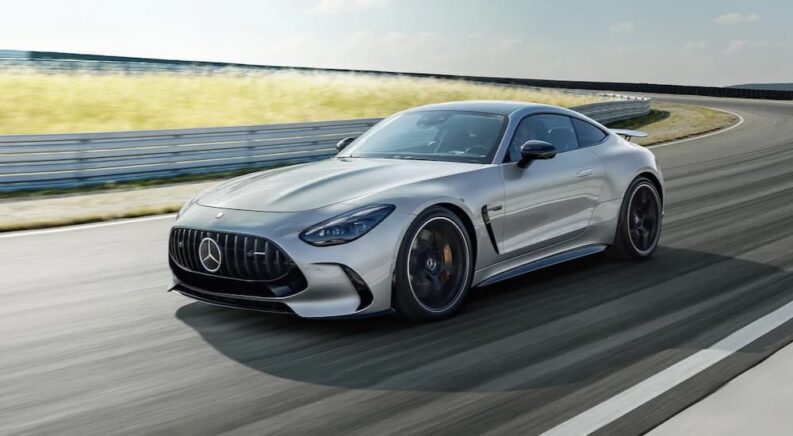Going fast and feeling exhilarated behind the wheel is about more than just raw horsepower and torque. While a true race car will be stripped down to save every ounce of weight possible, shoppers spending six figures on a performance car for the road usually expect more in the way of luxuries. To succeed in the rarefied air of the grand touring market, a car must be both powerful and elegant.
Think such a combination is a fantasy? Then you haven’t met the Mercedes-AMG GT. Since it was introduced for the 2015 model year, this coupe has been known for pairing the heart of a thoroughbred racing machine with the styling of a true luxury car. The result is a high-power machine that will fly on the level of some supercars and look good doing it.
With Mercedes having redesigned the AMG GT for 2024, I thought it was a good time to revisit this 21st-century sports car—not just to see how great it performs but how the automaker has made it possible. It’s a testament to modern engineering and a long-term partnership that squeezes every ounce of performance from a vehicle.
Bringing New Life to Coupes
When Mercedes unveiled the AMG GT at the Paris Motor Show in 2014, people immediately took notice of the vehicle’s small size—not just the body, but the engine inside. Like other high-end manufacturers, Mercedes has long been known for using 12-cylinder engines in its flagship vehicles. Beginning with the M120 power plant in 1991, V12s powered vehicles like the W140 and SL600 that blew the automotive world away.
However, the AMG GT carried a 4.0L V8 engine while still being designated a supercar. It was notable that Mercedes would develop a halo car that didn’t have a V12. But as it turned out, it didn’t need 12 cylinders to blister roads. The original AMG GT immediately made a statement, picking up the World Performance Car prize at the 2015 World Car Awards and winning the MotorTrend 2015 Best Driver’s Car Award. The vehicle proved to be an omen as well, with Mercedes announcing in 2018 that its V12 engines would be phased out.
Getting Ripped: The AMG-GT Design
What did Mercedes-AMG do to create such a lean and mean machine? The answer is twofold. For starters, AMG gets everything it can from the handcrafted engine. The design is known as a “hot V,” which is when the turbochargers are placed within the V-shaped cylinder bank. Doing so lets the turbocharged air take a shorter path to the intake, reducing lag for more power. It also makes for more compact packaging, which helps shave weight from the vehicle. The 4.0L M178 engine allowed for 456 hp from the first-gen AMG GT and 503 hp from the GT S.
Part two involves the use of premium materials to reduce weight while maintaining strength. Drivers of the original AMG GT were treated to a frame that was 90 percent aluminum and used magnesium components, two materials known for an incredible strength-to-weight ratio. The only major body part made of steel was the trunk lid—and that’s because engineers found it was the one case where steel was the lighter option. It even had a carbon fiber driveshaft to link the engine and the gearbox. Like a welterweight boxer, there’s barely an ounce of fat to be seen.
The result was a vehicle that had a curb weight of 3,560 lbs. By comparison, the more mundane 2015 Ford Mustang GT weighed 3,705 lbs with a manual transmission. So, while the 2015 AMG GT only had about five percent more horsepower than the Mustang GT on paper, when you factor in the reduced weight, its power-to-weight ratio was about 10 percent better! That’s a lot of ponies for the road or the track and contributed to its 3.8-second launch from zero to 60 mph.
Roar Like a Lion, Soar Like an Eagle
The new generation of the Mercedes-AMG GT continues the precedent set. Though designed to be more of a grand touring car than a supercar (the second-gen AMG GT uses the same underpinnings as the Mercedes-Benz SL roadster and has 2+2 seating), it remains true to the concept of putting a lot of horsepower in a sleek body. The AMG GT still has a composite aluminum body, carbon fiber bracing, magnesium instrument panel, and other materials chosen to keep the weight to a minimum.
Admittedly, the new version does weigh significantly more than the original, with an estimated curb weight of 4,343 lbs. This is mainly because the vehicle is bigger, period. It has a 2.8-inch longer wheelbase, a three-inch wider stance, and a 2.6-inch higher roofline. Mercedes-AMG has found two ways to counter this, though. One is with fine-tuned aerodynamics based on Formula 1 cars to get the vehicle down out of the air. The second is more powerful than ever. The new Mercedes AMG-GT V8 engine is still four liters but has a pair of twin-scroll turbochargers and advanced machining. This makes 469 hp and 516 lb-ft of torque on the GT 55 trim. When you hop into the GT 63, it jumps to 577 hp and 590 lb-ft of torque.
That much power means a manufacturer-estimated top speed of 196 mph and an official zero to 60 mph time of 3.1 seconds (although Car and Driver clocked an unofficial 2.9 seconds in the GT 63). For the GT 55, you’re looking at a still-impressive 183 mph and 3.8 seconds. Let’s compare these numbers to a few rivals in the coupe category:
Ford Mustang Dark Horse
- 500 hp / 418 lb-ft of torque
- Curb Weight: 3,949 lbs
- Top Speed: 166 mph
- 0-60 Time: 4.1 seconds
BMW M8 Competition
- 617 hp / 553 lb-ft of torque
- Curb Weight: 4,560 lbs
- Top Speed: 190 mph
- 0-60 Time: 3.0 seconds
Lexus LC 500
- 471 hp / 398 lb-ft of torque
- Curb Weight: 4,340 lbs
- Top Speed: 168 mph
- 0-60 Time: 4.4 seconds
As you can see, while some of its competitors can rival or surpass the Mercedes-AMG GT in individual categories, none can match the total package of acceleration and top speed the Mercedes-AMG GT brings to the table thanks to its incredible power-to-weight ratio. Furthermore, the 196 mph top speed is only due to an electronic limiter from the automaker. By tuning the ECU a little, you can potentially surpass the magical 200 mph barrier.
A Luxurious Road Warrior
Some automakers are known for excessive power, while others are known for great body and frame designs. The Mercedes-AMG GT shows what happens when you nail both. It’s strong, nimble, and ready to push the limits, outracing every other rival coupe. With the pending introduction of the turbo-four GT 43—which “only” generates 416 hp but will weigh an estimated 400 lbs less than the GT 55—performance enthusiasts will have a third prizefighter to choose from.
If you enjoy having a thrill a minute behind the wheel, do yourself a favor and give the Mercedes-AMG GT a try. To complement its powerful and stylish design, it has added driving technology such as an active ride control suspension, active rear steering, and a limited-slip differential for good measure, making it perform just as well in the turns as on the straightaways.






